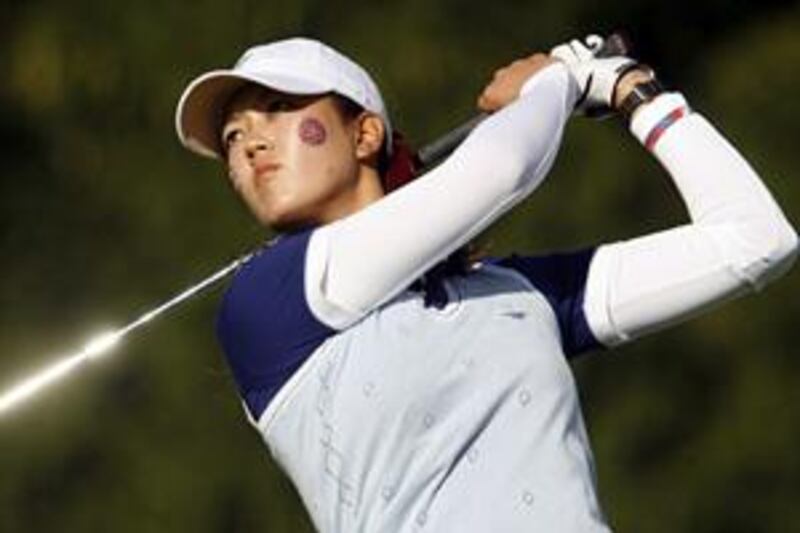In the wake of the USA's victory over Europe in the Solheim Cup, Michelle Wie has re-emerged as a player who can have as big an influence on ladies' golf as Tiger Woods has had on the men's game. After seeing her produce easily the most impressive golf last week, I believe Wie can become an even more powerful figure than Woods, both in terms of the impact she has on ladies' golf and the dominance she enjoys over her contemporaries.
They key is whether she can play with the freedom which was so evident through her early career but which seemed to have been lost during her transition from teenage sensation to full-time tournament professional. There have been murmurings for some time that the girl wonder was under the control of parents who had her best interests at heart but were unwittingly blighting their daughter's career.
Like any golfer, Wie needs freedom of thought to make the correct decisions on the golf course in order to capitalise on her extraordinary talent. No parent has had a bigger influence on a player's career than Earl Woods, but while Tiger has always acknowledged his father's huge contribution, he has always been the decision-maker on course. Ever since taking up the game as a four-year-old, Wie has shown maturity far beyond her years, with the power and ability to play to a standard never achieved by any other lady golfer.
At 10, she was the youngest player to qualify for the Women's US Amateur Public Links Championship. At 11, she won the Hawaii State Women's Stroke Play Championship. As a 12-year-old, she captured the Hawaii State Open Women's Division, winning by 13 shots over LPGA players, and became the youngest to qualify for an LPGA event, the Takefuji Classic. At 13 she was the youngest player to make the cut at Nabisco Championship on the LPGA.
Playing in the 2004 Sony Open in Hawaii at 14, she was the youngest female to contest a PGA Tour event, missing the cut by just one shot. She followed with two runners-up spots, and a week before her 16th birthday she turned professional, signing multi-million dollar sponsorship contracts. Since then she has failed to win an LPGA event, and questions have been raised about her parents' influence. In the 2005 LPGA Championship, Wie was within a shot of leader Annika Sorenstam with one hole to play, a par five dog-leg left with a bunker on the right corner.
She had discussed the hole with her father that morning and they agreed on a strategy to hit a five wood off the tee to stay short of the bunker. But the tee had been moved forward 50 yards that day and Wie's caddy advised her to hit the driver over the corner, leaving a wedge to the green and setting up a possible birdie or eagle. It was the logical choice, but Wie stuck with the five wood, sending her ball into a bunker from where she could only fashion a par, killing her chances of victory.
It is a glaring example of how poor decision-making has led to a unique player, who could not stop winning as an amateur, finding success elusive in almost four years as a professional. Wie's parents are both native South Koreans who moved to the US in the 1980s. Her father is a former university professor and her mother a former South Korean women's amateur golf champion. It is easy to see why she has been so strongly influenced by her parents, and just as easy to understand how an individual, no matter how talented, can struggle to produce their best in any sport when it is often the self-belief of an athlete which separates them from the rest.
During the Solheim Cup the players stayed on site all week, with parents not allowed on the range, in the players lounge or the team hotel. Suddenly, Wie was playing with a new-found freedom and enjoying her golf again. The atmosphere was incredible and Wie went with the flow, playing the right shots and displaying great versatility, showing there are no limitations in her game. She now appears ready to finally cut the umbilical cord and rediscover the joy of golf, which after all is a game that, at any level, is meant to be fun. It will be another learning experience for Wie, but one that can take her game to the next level. When that happens, the victories will flow.
She appears to have corrected a technical problem, replacing fast hip movement - something Tiger has fought against - with a smooth transition from the top of her swing. She now has a great position at the top and the movement through impact looks effortless, generating enormous power. At Sugar Grove, she made difficult shots look easy, producing many beyond any other player from either team. She took a while to be able to do what her coach, David Leadbetter, was asking, but the wait has been worthwhile. Lately she has been working on her putting with former PGA Champion Dave Stockton, who is trying to stop her being too mechanical on the greens.
Most importantly, last week, Wie found out how good she can be when making her own choices. Having lost sponsorship to the global economic crisis, the LPGA Tour needs the pulling power she showed at the Solheim Cup which attracted more than 135,000 spectators, the biggest galleries following her matches. She has the ability to take women's golf to a level never previously attained and become a huge role model for young girls all over the world.
Former Tour player Philip Parkin is a TV golf commentator with the BBC in Europe and Golf Channel in the US pparkin@thenational.ae





